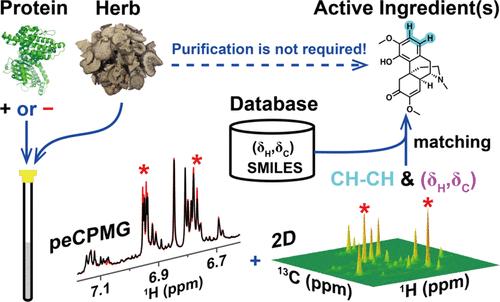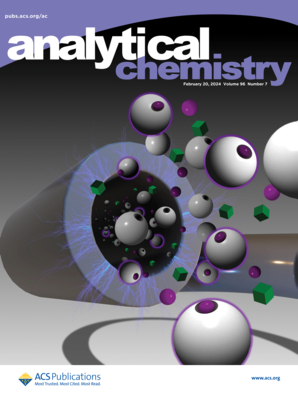Rapid Targeted Screening and Identification of Active Ingredients in Herbal Extracts through Ligand-Detected NMR and Database Matching
IF 6.7
1区 化学
Q1 CHEMISTRY, ANALYTICAL
引用次数: 0
Abstract
Herbal extracts are rich sources of active compounds that can be used for drug screening due to their diverse and unique chemical structures. However, traditional methods for screening these compounds are notably laborious and time-consuming. In this manuscript, we introduce a new high-throughput approach that combines nuclear magnetic resonance (NMR) spectroscopy with a tailored database and algorithm to rapidly identify bioactive components in herbal extracts. This method distinguishes characteristic signals and structural motifs of active constituents in the raw extracts through a relaxation-weighted technique, particularly utilizing the perfect echo Carr–Purcell–Meiboom–Gill (peCPMG) sequence, complemented by precise 2D spectroscopic strategies. The cornerstone of our approach is a customized database designed to filter potential compounds based on defined parameters, such as the presence of CHn segments and unique chemical shifts, thereby expediting the identification of promising compounds. This innovative technique was applied to identifying substances interacting with choline kinase α (ChoKα1), resulting in the discovery of four new inhibitors. Our findings demonstrate a powerful tool for unraveling the complex chemical landscape of herbal extracts, considerably facilitating the search for new pharmaceutical candidates. This approach offers an efficient alternative to traditional methods in the quest for drug discovery from natural sources.

通过配体检测核磁共振和数据库匹配,快速靶向筛选和鉴定草药提取物中的活性成分
草药提取物因其化学结构的多样性和独特性,是可用于药物筛选的活性化合物的丰富来源。然而,筛选这些化合物的传统方法费时费力。在本手稿中,我们介绍了一种新的高通量方法,它将核磁共振(NMR)光谱与定制数据库和算法相结合,可快速鉴定草药提取物中的生物活性成分。这种方法通过弛豫加权技术,特别是利用完美回波卡尔-普塞尔-梅博姆-吉尔(peCPMG)序列,辅以精确的二维光谱策略,来区分原始提取物中活性成分的特征信号和结构模式。我们方法的基石是一个定制的数据库,旨在根据定义的参数(如是否存在 CHn 段和独特的化学位移)过滤潜在的化合物,从而加快识别有潜力的化合物。这项创新技术被应用于鉴定与胆碱激酶α(ChoKα1)相互作用的物质,结果发现了四种新的抑制剂。我们的研究结果展示了一种强大的工具,可用于揭示草药提取物的复杂化学图谱,大大促进了新药候选物的寻找。这种方法为从天然资源中发现药物提供了一种传统方法之外的有效替代方法。
本文章由计算机程序翻译,如有差异,请以英文原文为准。
求助全文
约1分钟内获得全文
求助全文
来源期刊

Analytical Chemistry
化学-分析化学
CiteScore
12.10
自引率
12.20%
发文量
1949
审稿时长
1.4 months
期刊介绍:
Analytical Chemistry, a peer-reviewed research journal, focuses on disseminating new and original knowledge across all branches of analytical chemistry. Fundamental articles may explore general principles of chemical measurement science and need not directly address existing or potential analytical methodology. They can be entirely theoretical or report experimental results. Contributions may cover various phases of analytical operations, including sampling, bioanalysis, electrochemistry, mass spectrometry, microscale and nanoscale systems, environmental analysis, separations, spectroscopy, chemical reactions and selectivity, instrumentation, imaging, surface analysis, and data processing. Papers discussing known analytical methods should present a significant, original application of the method, a notable improvement, or results on an important analyte.
 求助内容:
求助内容: 应助结果提醒方式:
应助结果提醒方式:


